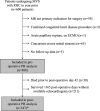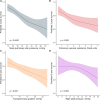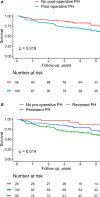Increased Mortality in Patients With Preoperative and Persistent Postoperative Pulmonary Hypertension Undergoing Mitral Valve Surgery for Mitral Regurgitation: A Cohort Study
- PMID: 33599144
- PMCID: PMC8174242
- DOI: 10.1161/JAHA.120.018394
Increased Mortality in Patients With Preoperative and Persistent Postoperative Pulmonary Hypertension Undergoing Mitral Valve Surgery for Mitral Regurgitation: A Cohort Study
Abstract
Background Preoperative pulmonary hypertension (PH) is associated with excess mortality among patients with severe mitral regurgitation undergoing mitral valve surgery (MVS). However, the links between PH phenotype, pulmonary vascular remodeling, and persistent postoperative PH are not well understood. We aimed to describe the associations between components of pulmonary hemodynamics as well as postoperative residual PH with longitudinal mortality in patients with severe mitral regurgitation who received MVS. Methods and Results Patients undergoing MVS for severe mitral regurgitation from 2011 to 2016 were retrospectively identified within our health system (n=488). Mean pulmonary artery pressure and other hemodynamic variables were determined by presurgical right-heart catheterization. Postoperative pulmonary artery systolic pressure was assessed on echocardiogram 42 to 365 days post-MVS. Longitudinal survival over a mean 3.9 years of follow-up was evaluated using Cox proportional hazards modeling to compare survival after adjustment for demographics, surgical characteristics, and comorbidities. Pre-MVS prevalence of PH was high at 85%. After adjustment, each 10-mm Hg increase in preoperative mean pulmonary artery pressure was associated with a 1.38-fold increase in risk of death (95% CI, 1.13-1.68). Elevated preoperative pulmonary vascular resistance, transpulmonary gradient, and right atrial pressure were similarly associated with increased mortality. Among 231 patients with postoperative echocardiogram, evidence of PH on echocardiogram (pulmonary artery systolic pressure ≥35 mm Hg) was associated with increased risk of death (hazard ratio [HR], 2.02 [95% CI, 1.17-3.47]); however, this was no longer statistically significant after adjustment (HR, 1.55 [95% CI, 0.85-2.85]). Conclusions In patients undergoing MVS for mitral regurgitation, preoperative PH, and postoperative PH were associated with increased mortality.
Keywords: mitral regurgitation; mitral valve surgery; mortality; pulmonary hypertension.
Conflict of interest statement
Dr Chan has served as a consultant for Aerpio, Zogenix, and United Therapeutics; is a director, officer, and shareholder in Numa Therapeutics; and has held research grants from Actelion and Pfizer. Dr Chan has filed patent applications on the targeting of metabolism in pulmonary hypertension. The remaining authors have no disclosures to report.
Figures




References
-
- Suri RM, Vanoverschelde J‐L, Grigioni F, Schaff HV, Tribouilloy C, Avierinos J‐F, Barbieri A, Pasquet A, Huebner M, Rusinaru D, et al. Association between early surgical intervention vs watchful waiting and outcomes for mitral regurgitation due to flail mitral valve leaflets. JAMA. 2013;310:609–616. DOI: 10.1001/jama.2013.8643. - DOI - PubMed
Publication types
MeSH terms
Grants and funding
LinkOut - more resources
Full Text Sources
Other Literature Sources
Medical

